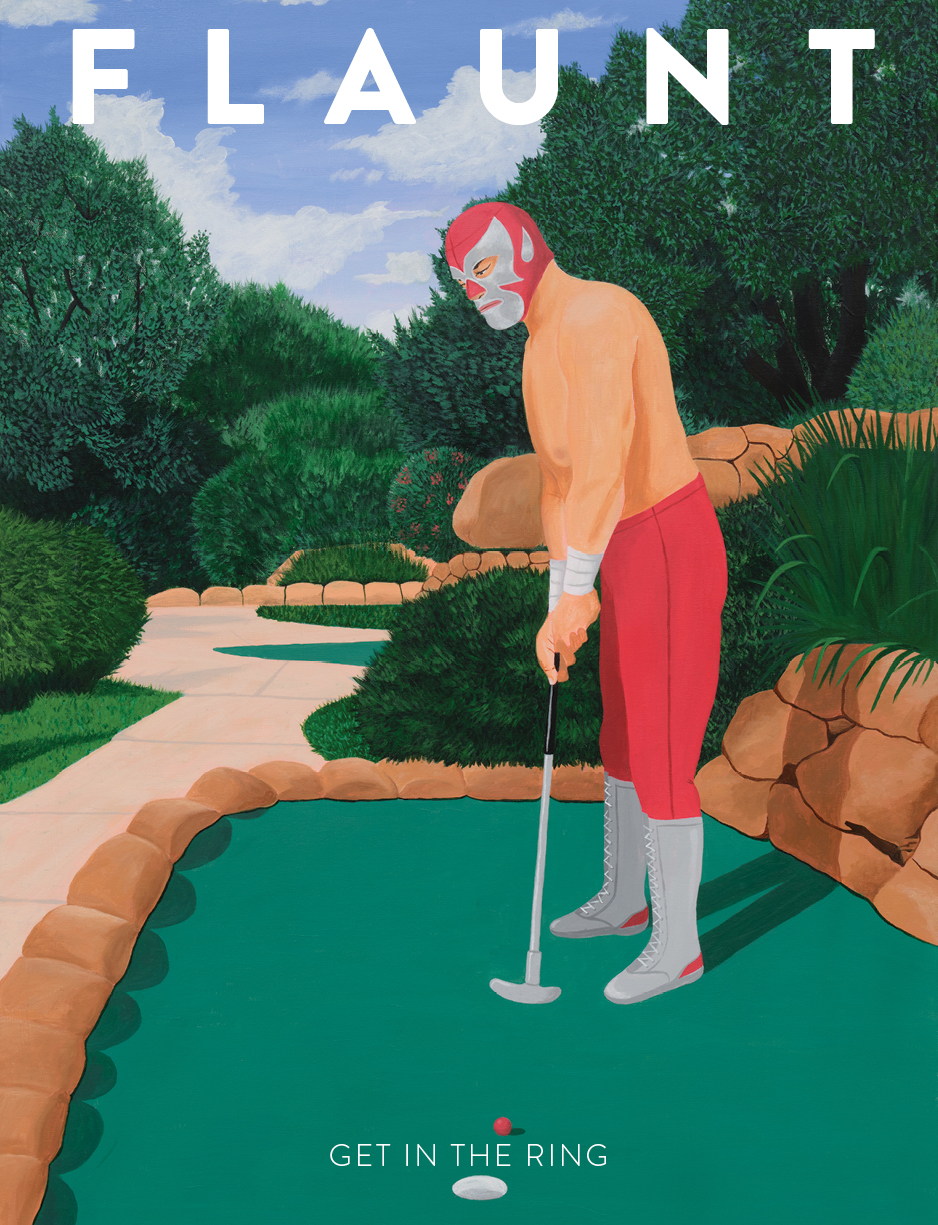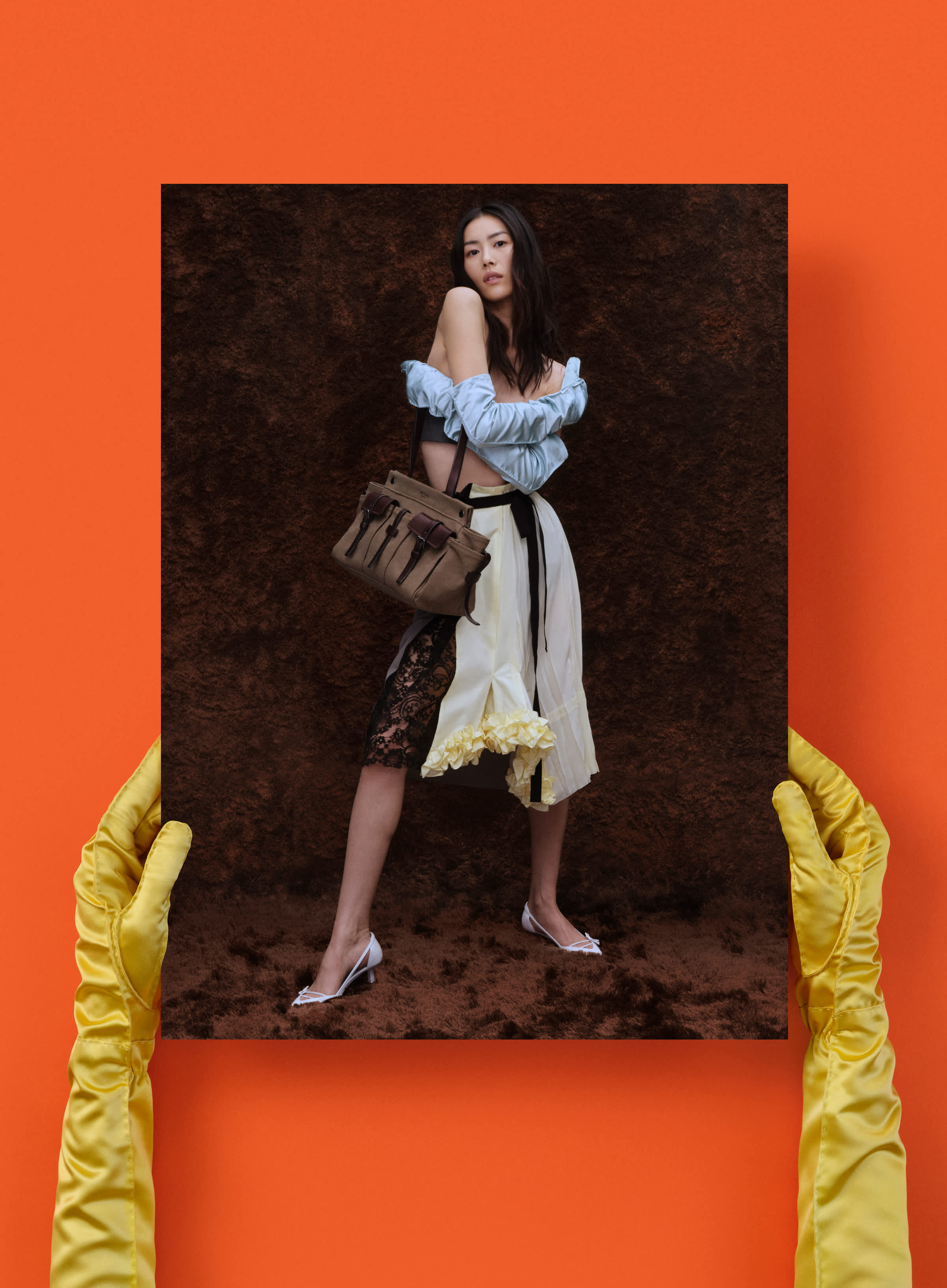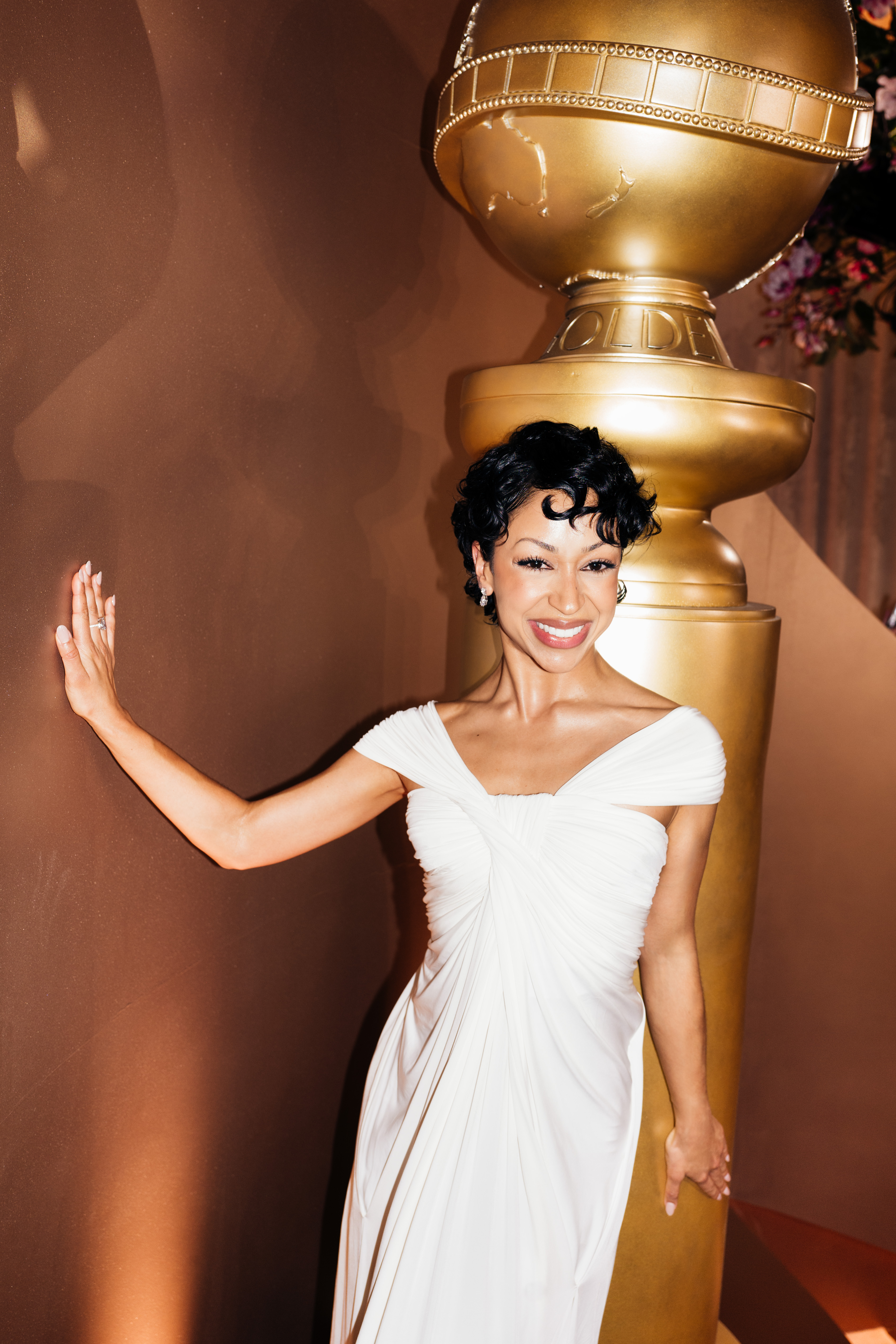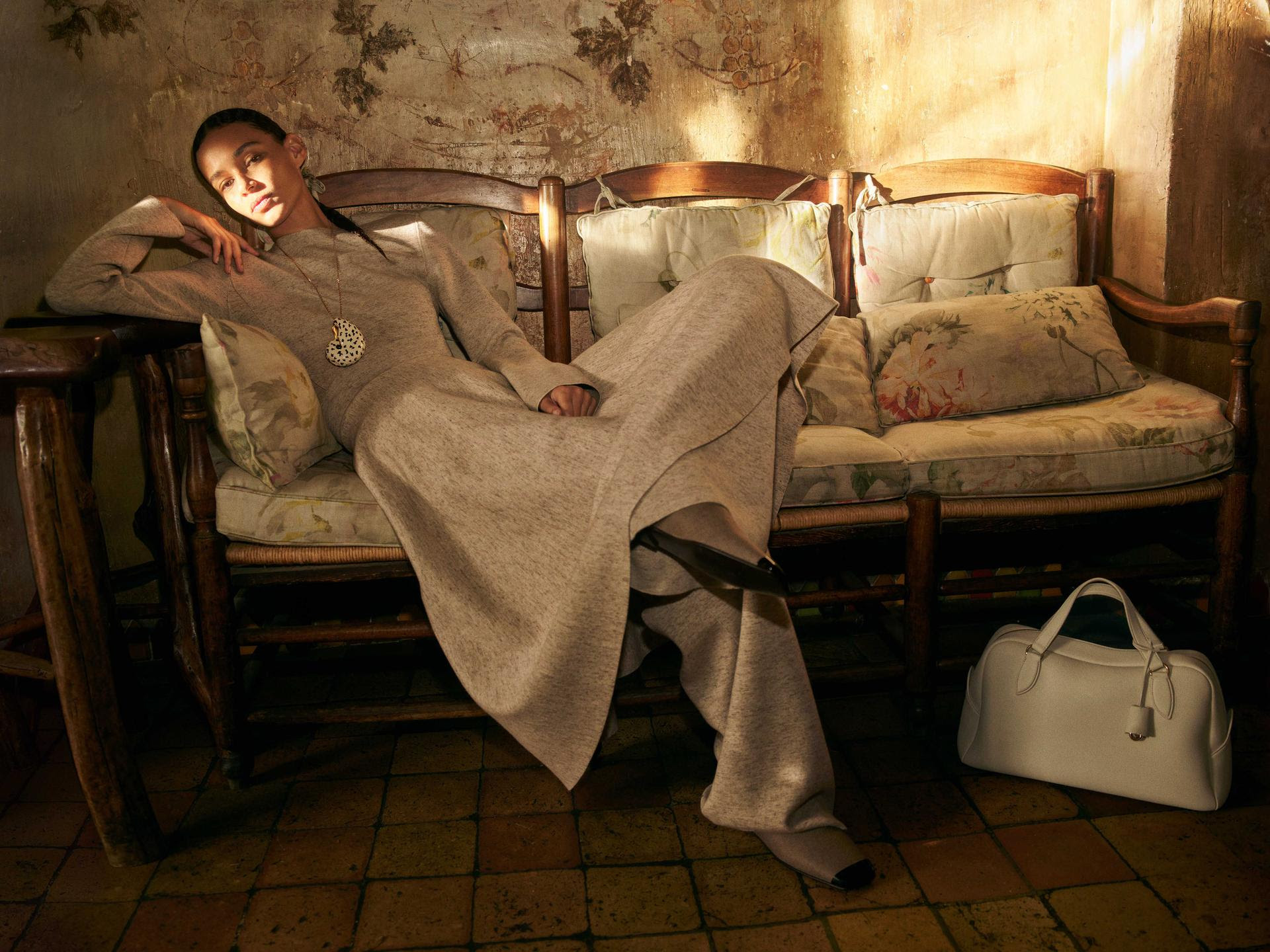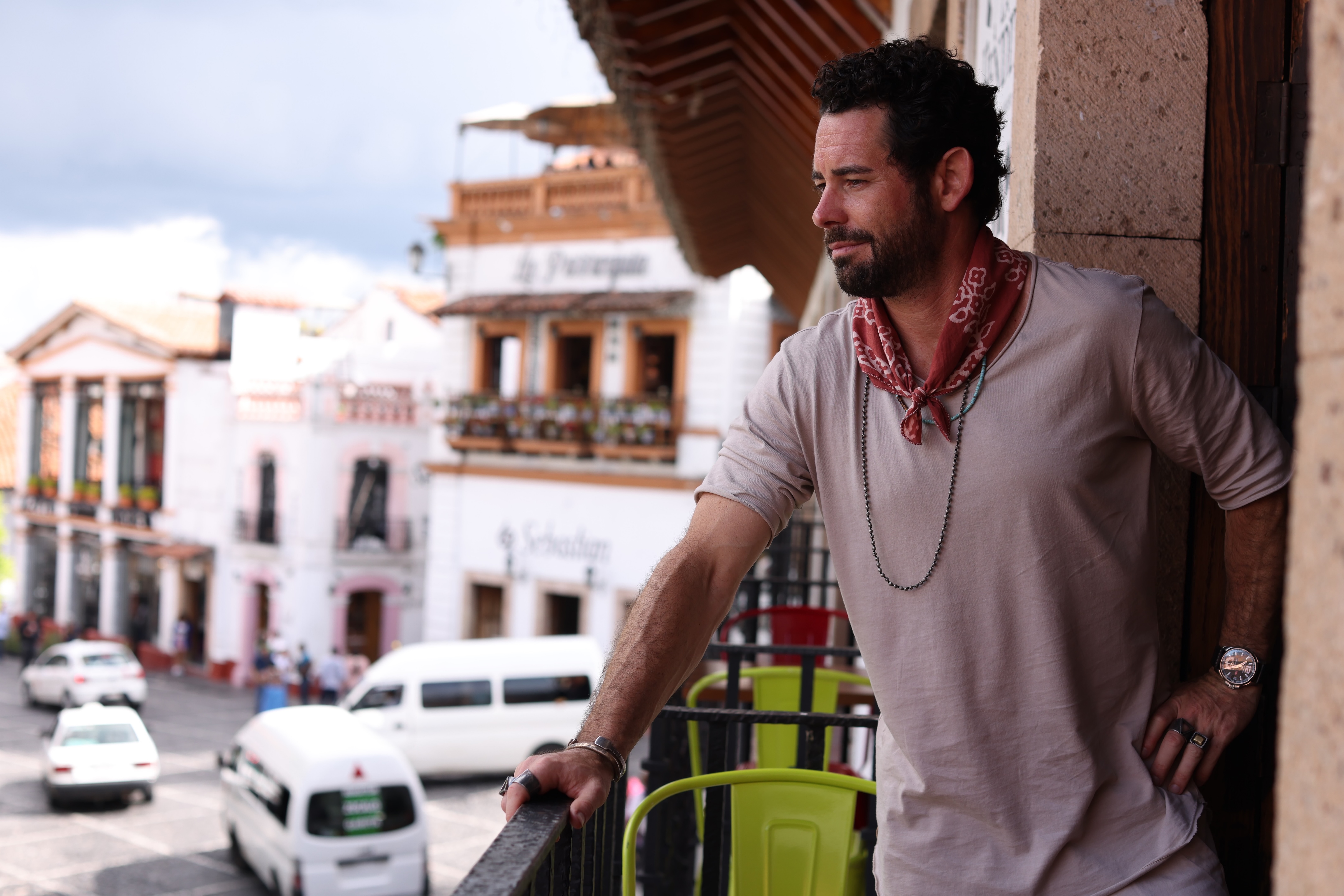

Brendan Fernandes.
Photo by: Eva Deitch
On display at [Monique Meloche](http://moniquemeloche.com/) gallery, multidisciplinary artist [Brendan Fernandes](https://www.instagram.com/brendanfernandes/) presents a new body of work entitled _Restrain_. Drawing inspiration from his recent performance at the Guggenheim in New York City, _Ballet Kink_ (2019), Fernandes uses his knowledge of the human form to remove its pains and pleasures from public discourse. With bronze, leather, walnut, and steel, Shibari bondage sculptures symbolize resistance, pain, pleasure, and freedom. Through the absence of a physical body, Brendan seeks to highlight the marginalized queer communities and demonized BDSM practices. Flaunt spoke with the artist and dancer to discuss his self-exploration and restraints.
**_How did the creation of this exhibition stage a self-exploration of the human figure?_**
In my work, I look at the human figure from the perspective of a dancer. Making these sculptures is an extension of that. The work is a nod to Shibari and BDSM kinks, but in these sculptures, the contour and form of the body are only represented. Much of my work is about the body, but also about the lost body linked to or indexed by an object. For example, my early work looks at how African Masks were once danced and performed, but in a museum context, the body and the dance are removed. These sculptures represent another exploration of the body through its absence, it being invisible or through a sense of loss.


_Kinbaku II_, 2019. Brendan Fernandes.
**_What aspects of your Ballet Kink performance at the Guggenheim inspired the development of this exhibit?_**
I have been using Shibari in my work and my life for quite some time. I have been working with riggers and learning myself how to tie up dancers. In both my life and my work, I am doing this to think about how we can find freedom within restraint. Most recently, I have been tying up dancers and asking them to move while in restraint. The challenge becomes a way to find new languages for movement and dance. For me, this is a key idea: the search for new ways to move under new forms of restriction has both conceptual and metaphoric resonance in our political moment. The Guggenheim performance was an important moment in this work’s development. This solo show at Monique Meloche Gallery also looks at these ideas. I was working through and conceiving of them both at the same time, and now that they have both come to fruition, they both are informing and generating new works.
**_As an artist and dancer, when did your interest in bodies and movement begin? How has this interest grown or changed throughout the completion of these works?_**
I started dancing when I was nine, and that gave me an awareness of my body as a form early on. When I stopped dancing due to injury in my 20’s I began to think more critically and mindfully about bodies and bodies that dance. My work now is about finding ways to see dance as political, to question the relationship between the desires and master hierarchies of dance and hegemony. Exploring this relationship includes looking at Ballet as a colonial structure, or BDSM and Shibari as ways of making still dance; or questioning the social and emotional security of the queer night club. Throughout the goal is to challenge hegemonies and to move towards solidarities.


Artist Rendering, Bronze. Brendan Fernandes.
**_Bronze, leather, walnut, and steel were your chosen mediums— Why?_**
In my undergraduate degree, I was a dance and sculpture major, and bronze casting was my main way of making. I love the lost wax process as it has historical resonance; not much has changed in the process in decades. Bronze casting is also like a dance in that there is a choreographic sequence to how it is made. Take, for example, the pouring process, everyone knows their role and move together to see it completed. Also, bronze as a material is flexible and can look like many different things. I love its weight but also how it can take on a lightness depending on its form. Leather, of course, is a nod to BDSM, and is a direct link back to the body as it is a bodily material––a skin. Walnut and steel replicate the museum apparatus that hold and support objects in stillness but used in more raw, unpolished forms, and they contrast with the starkness of these spaces. Together they are a seductive combination of materials, evoking the body, and the many forms it can take was the goal.


_Kinbaku Arm_, 2019. Brendan Fernandes.
**_“Restrain” symbolizes resistance, pain, freedom, and pleasure, specifically for marginalized peoples. What open dialogue would you like to create in this space?_**
The idea with this exhibition is to create new ways of seeing, new forms of visibility and to draw attention to absences. With an exhibition without dancers, there is naturally less conversation about the status of particular bodies in public space, but within this exhibition, there is the choice to represent bodies by the devices and structures that hold them rather than by the image or presence of the body itself. We must look at and talk about the social and political structures around bodies as much we want to talk about the bodies themselves.
**_What are your viewpoints on the censorship and “community guidelines” on social media? Particularly for queer, BDSM and kink practitioners._**
I feel we are in very precarious times where social media is not allowing many forms of queer or counter-culture to be made viable and heard. Censorship further supports taboos and stigmas. This further marginalizes bodies that are denied to empower themselves as queer or to mark themselves as different. This censorship is a way to make society homogenous and to set controls. The use of “community guidelines” is of interest to me as it doesn’t support my idea of community. These “guidelines” are rules that further perpetuate heteronormativity via capitalism.


Artist Rendering, Bronze. Brendan Fernandes.
**_How will your exploration of bodies and movement continue?_**
I have begun to think about dance via protest, and I am now looking at ways to disseminate and make choreographies that are social and political that can be spread to mass populations. I have been thinking about how the Hong Kong protesters were cut off from the internet and how they were using Airdrop to call, gather, and inform each other. My new works look at using this platform to make dance.
* * *
 
Brendan Fernandes.
Photo by: Eva Deitch
On display at [Monique Meloche](http://moniquemeloche.com/) gallery, multidisciplinary artist [Brendan Fernandes](https://www.instagram.com/brendanfernandes/) presents a new body of work entitled _Restrain_. Drawing inspiration from his recent performance at the Guggenheim in New York City, _Ballet Kink_ (2019), Fernandes uses his knowledge of the human form to remove its pains and pleasures from public discourse. With bronze, leather, walnut, and steel, Shibari bondage sculptures symbolize resistance, pain, pleasure, and freedom. Through the absence of a physical body, Brendan seeks to highlight the marginalized queer communities and demonized BDSM practices. Flaunt spoke with the artist and dancer to discuss his self-exploration and restraints.
**_How did the creation of this exhibition stage a self-exploration of the human figure?_**
In my work, I look at the human figure from the perspective of a dancer. Making these sculptures is an extension of that. The work is a nod to Shibari and BDSM kinks, but in these sculptures, the contour and form of the body are only represented. Much of my work is about the body, but also about the lost body linked to or indexed by an object. For example, my early work looks at how African Masks were once danced and performed, but in a museum context, the body and the dance are removed. These sculptures represent another exploration of the body through its absence, it being invisible or through a sense of loss.

Brendan Fernandes.
Photo by: Eva Deitch
On display at [Monique Meloche](http://moniquemeloche.com/) gallery, multidisciplinary artist [Brendan Fernandes](https://www.instagram.com/brendanfernandes/) presents a new body of work entitled _Restrain_. Drawing inspiration from his recent performance at the Guggenheim in New York City, _Ballet Kink_ (2019), Fernandes uses his knowledge of the human form to remove its pains and pleasures from public discourse. With bronze, leather, walnut, and steel, Shibari bondage sculptures symbolize resistance, pain, pleasure, and freedom. Through the absence of a physical body, Brendan seeks to highlight the marginalized queer communities and demonized BDSM practices. Flaunt spoke with the artist and dancer to discuss his self-exploration and restraints.
**_How did the creation of this exhibition stage a self-exploration of the human figure?_**
In my work, I look at the human figure from the perspective of a dancer. Making these sculptures is an extension of that. The work is a nod to Shibari and BDSM kinks, but in these sculptures, the contour and form of the body are only represented. Much of my work is about the body, but also about the lost body linked to or indexed by an object. For example, my early work looks at how African Masks were once danced and performed, but in a museum context, the body and the dance are removed. These sculptures represent another exploration of the body through its absence, it being invisible or through a sense of loss.
 
_Kinbaku II_, 2019. Brendan Fernandes.
**_What aspects of your Ballet Kink performance at the Guggenheim inspired the development of this exhibit?_**
I have been using Shibari in my work and my life for quite some time. I have been working with riggers and learning myself how to tie up dancers. In both my life and my work, I am doing this to think about how we can find freedom within restraint. Most recently, I have been tying up dancers and asking them to move while in restraint. The challenge becomes a way to find new languages for movement and dance. For me, this is a key idea: the search for new ways to move under new forms of restriction has both conceptual and metaphoric resonance in our political moment. The Guggenheim performance was an important moment in this work’s development. This solo show at Monique Meloche Gallery also looks at these ideas. I was working through and conceiving of them both at the same time, and now that they have both come to fruition, they both are informing and generating new works.
**_As an artist and dancer, when did your interest in bodies and movement begin? How has this interest grown or changed throughout the completion of these works?_**
I started dancing when I was nine, and that gave me an awareness of my body as a form early on. When I stopped dancing due to injury in my 20’s I began to think more critically and mindfully about bodies and bodies that dance. My work now is about finding ways to see dance as political, to question the relationship between the desires and master hierarchies of dance and hegemony. Exploring this relationship includes looking at Ballet as a colonial structure, or BDSM and Shibari as ways of making still dance; or questioning the social and emotional security of the queer night club. Throughout the goal is to challenge hegemonies and to move towards solidarities.

_Kinbaku II_, 2019. Brendan Fernandes.
**_What aspects of your Ballet Kink performance at the Guggenheim inspired the development of this exhibit?_**
I have been using Shibari in my work and my life for quite some time. I have been working with riggers and learning myself how to tie up dancers. In both my life and my work, I am doing this to think about how we can find freedom within restraint. Most recently, I have been tying up dancers and asking them to move while in restraint. The challenge becomes a way to find new languages for movement and dance. For me, this is a key idea: the search for new ways to move under new forms of restriction has both conceptual and metaphoric resonance in our political moment. The Guggenheim performance was an important moment in this work’s development. This solo show at Monique Meloche Gallery also looks at these ideas. I was working through and conceiving of them both at the same time, and now that they have both come to fruition, they both are informing and generating new works.
**_As an artist and dancer, when did your interest in bodies and movement begin? How has this interest grown or changed throughout the completion of these works?_**
I started dancing when I was nine, and that gave me an awareness of my body as a form early on. When I stopped dancing due to injury in my 20’s I began to think more critically and mindfully about bodies and bodies that dance. My work now is about finding ways to see dance as political, to question the relationship between the desires and master hierarchies of dance and hegemony. Exploring this relationship includes looking at Ballet as a colonial structure, or BDSM and Shibari as ways of making still dance; or questioning the social and emotional security of the queer night club. Throughout the goal is to challenge hegemonies and to move towards solidarities.
 
Artist Rendering, Bronze. Brendan Fernandes.
**_Bronze, leather, walnut, and steel were your chosen mediums— Why?_**
In my undergraduate degree, I was a dance and sculpture major, and bronze casting was my main way of making. I love the lost wax process as it has historical resonance; not much has changed in the process in decades. Bronze casting is also like a dance in that there is a choreographic sequence to how it is made. Take, for example, the pouring process, everyone knows their role and move together to see it completed. Also, bronze as a material is flexible and can look like many different things. I love its weight but also how it can take on a lightness depending on its form. Leather, of course, is a nod to BDSM, and is a direct link back to the body as it is a bodily material––a skin. Walnut and steel replicate the museum apparatus that hold and support objects in stillness but used in more raw, unpolished forms, and they contrast with the starkness of these spaces. Together they are a seductive combination of materials, evoking the body, and the many forms it can take was the goal.

Artist Rendering, Bronze. Brendan Fernandes.
**_Bronze, leather, walnut, and steel were your chosen mediums— Why?_**
In my undergraduate degree, I was a dance and sculpture major, and bronze casting was my main way of making. I love the lost wax process as it has historical resonance; not much has changed in the process in decades. Bronze casting is also like a dance in that there is a choreographic sequence to how it is made. Take, for example, the pouring process, everyone knows their role and move together to see it completed. Also, bronze as a material is flexible and can look like many different things. I love its weight but also how it can take on a lightness depending on its form. Leather, of course, is a nod to BDSM, and is a direct link back to the body as it is a bodily material––a skin. Walnut and steel replicate the museum apparatus that hold and support objects in stillness but used in more raw, unpolished forms, and they contrast with the starkness of these spaces. Together they are a seductive combination of materials, evoking the body, and the many forms it can take was the goal.
 
_Kinbaku Arm_, 2019. Brendan Fernandes.
**_“Restrain” symbolizes resistance, pain, freedom, and pleasure, specifically for marginalized peoples. What open dialogue would you like to create in this space?_**
The idea with this exhibition is to create new ways of seeing, new forms of visibility and to draw attention to absences. With an exhibition without dancers, there is naturally less conversation about the status of particular bodies in public space, but within this exhibition, there is the choice to represent bodies by the devices and structures that hold them rather than by the image or presence of the body itself. We must look at and talk about the social and political structures around bodies as much we want to talk about the bodies themselves.
**_What are your viewpoints on the censorship and “community guidelines” on social media? Particularly for queer, BDSM and kink practitioners._**
I feel we are in very precarious times where social media is not allowing many forms of queer or counter-culture to be made viable and heard. Censorship further supports taboos and stigmas. This further marginalizes bodies that are denied to empower themselves as queer or to mark themselves as different. This censorship is a way to make society homogenous and to set controls. The use of “community guidelines” is of interest to me as it doesn’t support my idea of community. These “guidelines” are rules that further perpetuate heteronormativity via capitalism.

_Kinbaku Arm_, 2019. Brendan Fernandes.
**_“Restrain” symbolizes resistance, pain, freedom, and pleasure, specifically for marginalized peoples. What open dialogue would you like to create in this space?_**
The idea with this exhibition is to create new ways of seeing, new forms of visibility and to draw attention to absences. With an exhibition without dancers, there is naturally less conversation about the status of particular bodies in public space, but within this exhibition, there is the choice to represent bodies by the devices and structures that hold them rather than by the image or presence of the body itself. We must look at and talk about the social and political structures around bodies as much we want to talk about the bodies themselves.
**_What are your viewpoints on the censorship and “community guidelines” on social media? Particularly for queer, BDSM and kink practitioners._**
I feel we are in very precarious times where social media is not allowing many forms of queer or counter-culture to be made viable and heard. Censorship further supports taboos and stigmas. This further marginalizes bodies that are denied to empower themselves as queer or to mark themselves as different. This censorship is a way to make society homogenous and to set controls. The use of “community guidelines” is of interest to me as it doesn’t support my idea of community. These “guidelines” are rules that further perpetuate heteronormativity via capitalism.
 
Artist Rendering, Bronze. Brendan Fernandes.
**_How will your exploration of bodies and movement continue?_**
I have begun to think about dance via protest, and I am now looking at ways to disseminate and make choreographies that are social and political that can be spread to mass populations. I have been thinking about how the Hong Kong protesters were cut off from the internet and how they were using Airdrop to call, gather, and inform each other. My new works look at using this platform to make dance.
* * *

Artist Rendering, Bronze. Brendan Fernandes.
**_How will your exploration of bodies and movement continue?_**
I have begun to think about dance via protest, and I am now looking at ways to disseminate and make choreographies that are social and political that can be spread to mass populations. I have been thinking about how the Hong Kong protesters were cut off from the internet and how they were using Airdrop to call, gather, and inform each other. My new works look at using this platform to make dance.
* * *
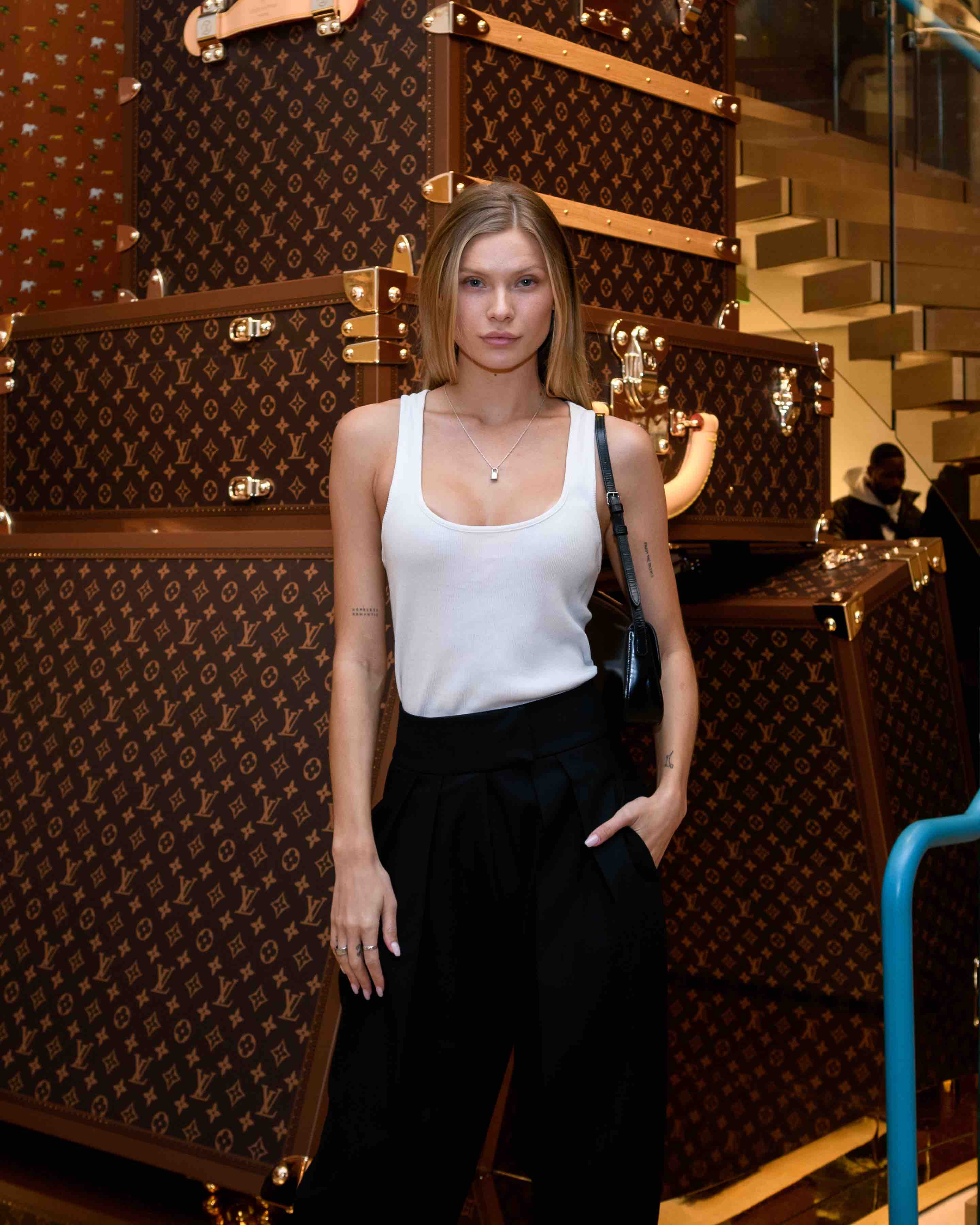
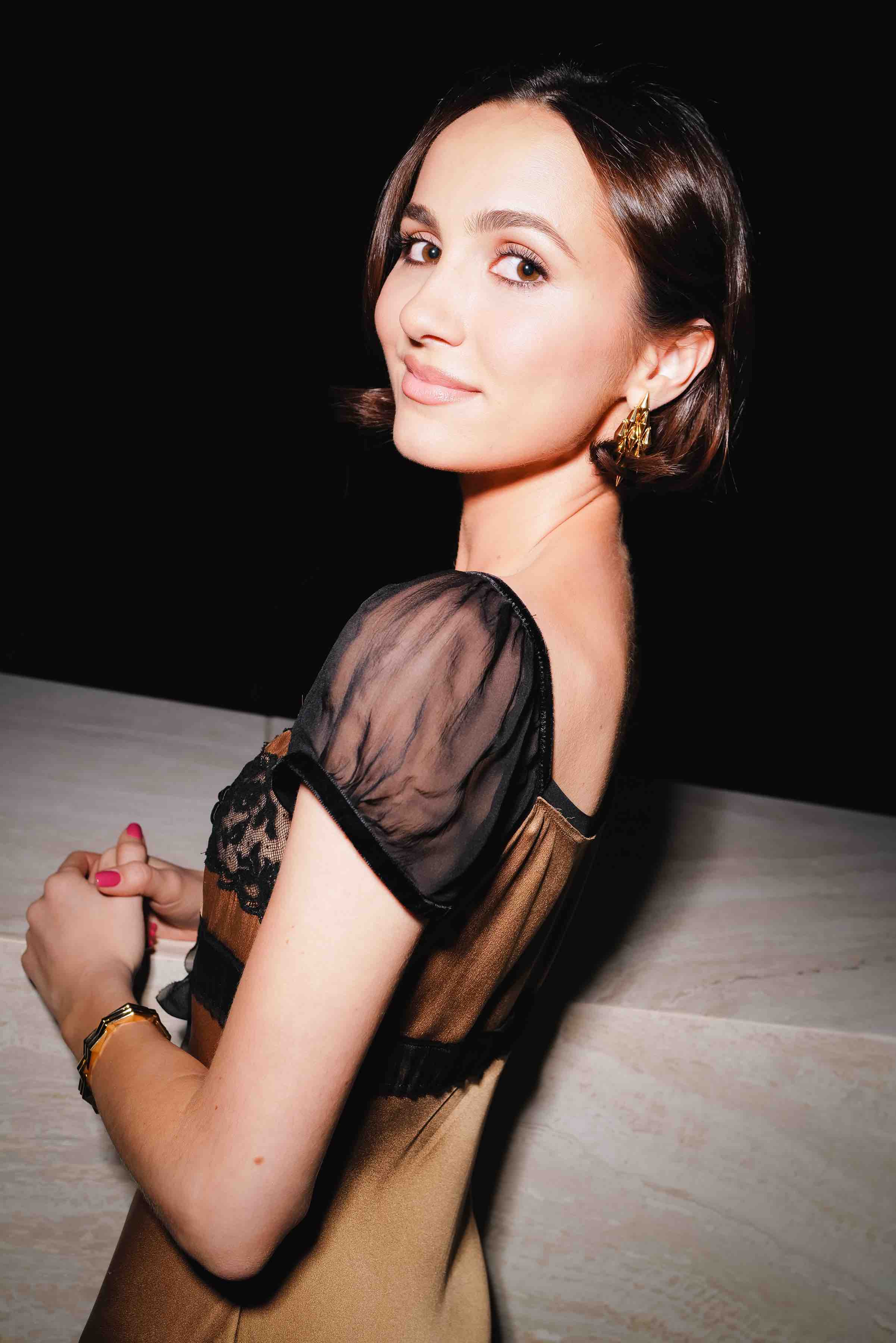

.jpeg)
